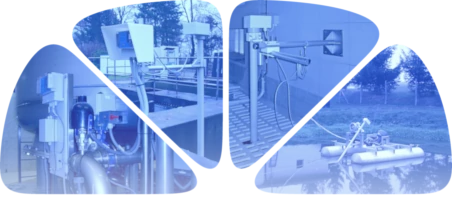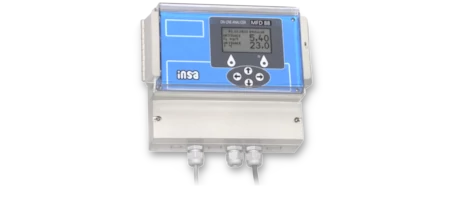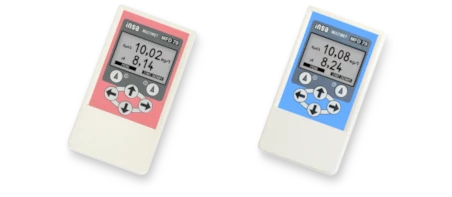Multi-parameter Instruments: Sensors
Appropriate sensor is fundamental to any measurement setup. Variety of different types and variants are available, depending on the measured quantities, sensor dimensions, as well as usage workflow, environment, and installation method. The vast majority of sensors listed below are just components of a larger measurement setup, and can therefore be satisfactorily used only with a compatible analyzer. Sensors for in-technology measurements should be installed inside our probes, ensuring their fixing and protection, and these connect to a terminal block. Variants for laboratory and portable usage are terminated with the appropriate connector. Sensors generally have the shortest lifetime of the entire setup, due to direct contact with the measured medium.
Optical oxygen sensors CSOT53

CSOT53 sensors are mainly used to measure and control the oxygen content in the activation tanks of biological WWTPs, in surface, underground and waste water or in fish farming facilities. CSOT53 is an optical sensor based on the principle of luminescence quenching by oxygen, fitting into a classic miniature outline (no input block integrated).
The P versions are designed for installation into fixed probes, while the L versions are suitable for use with desktop and portable instruments. We also offer a version compatible with standardized ground glass joints (primarily for BOD measurement).
- Accurate measurement in both still and flowing water, thanks to zero dependency on flow rate.
- Smooth surface of the plastic membrane allows self-cleaning of the sensor in flowing water (typical for WWTP activation tanks) and thus lower maintenance requirements.
- Long service life of the sensor and the membrane head, with maximum simplicity of head replacement.
- Virtually no need for recalibration.
- Resistance to the effects of CO2, SO2, H2S significantly increases the reliability of measurements, especially in WWTPs.
| Type | Suitable for | Dimensions | Operating and storage temperature |
| CSOT53PS | Installation with SPO41, SPO41K, SPO42, SPO41MEK, PB42V, PB43V, PE G3/4K | Ø14.5 x 57 mm | -5 to +50 °C |
| CSOT53PL | Installation with SPR42, SPR41ME, PE G3/4L, SVK42 | Ø14.5 x 113 mm | -5 to +50 °C |
| CSOT53PSN | Installation with SPO41MEK, PE G3/4K | Ø14.5 x 57 mm | -5 to +70 °C |
| CSOT53S | Installation inside pipes (stainless steel fitting) | Ø14.5 / Ø25 x 127 mm | -5 to +70 °C |
| CSOT53LS | Laboratory measurements | Ø14.5 / Ø18 x 158 mm | -5 to +50 °C |
| CSOT53LZ | Portable instruments (with protective cover) | Ø14.5 / Ø18 x 98 mm | -5 to +50 °C |
| CSOT53LPS | Laboratory, measurements in enclosed units | Ø14.5 x 79 mm | -5 to +50 °C |
| CSOT53LL | Laboratory, measurements in bottles (extended length) | Ø14.5 / Ø18 x 208 mm | -5 to +50 °C |
| CSOT53LST | Laboratory, for containers with ground glass joints | Ø14.5 x 108 mm, ST 19/26 | -5 to +50 °C |
| Principle | Optical, quenching of luminescence by oxygen | ||
| Compatibility | INSA analyzers and instruments only | ||
| Measurement range | 0.1 - 20 mg/l or 1 - 150 % | ||
| Resolution | 0.01 mg/l or 0.1 % | ||
| Response time | ca 45 sec. | ||
| Flow of the sample | Not required | ||
| Pressure | max. 0.6 MPa | ||
| Materials in contact with medium | Polyethylene terephthalate, EPDM, PTFE, PP, silicone, stainless steel | ||
Oxygen sensors CSOT43
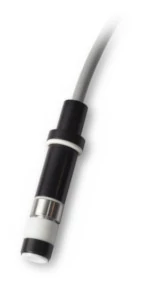
CSOT43 sensors are mainly used to measure and control the oxygen content in the activation tanks of biological WWTPs, in surface, underground and waste water or in fish farming facilities. CSOT43 is a classic Clark type sensor, with robust all-glass two-electrode detection system and a small-area cathode. Compared to modern optical sensors, its advantage is primarily a faster response, as well as the ability to measure very high values.
The P versions are designed for installation into fixed probes, while the L versions are suitable for use with desktop and portable instruments.
- Optimal size of the electrodes and the electrolyte supply ensures perfect linearity, excellent time stability and long maintenance-free operation, without the need for electrolyte replacement, or a third electrode.
- Extremely low oxygen consumption reduces the demands on the flow of the measured water. The sensor can work in virtually any conditions, without additional stirring.
- Smooth surface of the plastic membrane allows self-cleaning of the sensor in flowing water (typical for WWTP activation tanks) and thus lower maintenance requirements.
| Type | Suitable for | Dimensions | Operating and storage temperature |
| CSOT43PS | Installation with SPO41, SPO41K, SPO42, SPO41MEK, PB42V, PB43V, PE G3/4K | Ø14.5 x 57 mm | -5 to +40 °C |
| CSOT43PL | Installation with SPR42, SPR41ME, PE G3/4L, SVK42 | Ø14.5 x 113 mm | -5 to +40 °C |
| CSOT43PSN | Installation with SPO41MEK, PE G3/4K | Ø14.5 x 57 mm | -5 to +80 °C |
| CSOT43S | Installation inside pipes (stainless steel fitting) | Ø14.5 / Ø25 x 127 mm | -5 to +80 °C |
| CSOT43LS | Laboratory measurements | Ø14.5 / Ø18 x 158 mm | -5 to +40 °C |
| CSOT43LZ | Portable instruments (with protective cover) | Ø14.5 / Ø18 x 98 mm | -5 to +40 °C |
| CSOT43LPS | Laboratory, measurements in enclosed units | Ø14.5 x 79 mm | -5 to +40 °C |
| CSOT43LL | Laboratory, measurements in bottles (extended length) | Ø14.5 / Ø18 x 208 mm | -5 to +40 °C |
| Principle | Clark type sensor | ||
| Measurement range | 0.1 - 30 mg/l | ||
| Electrode current | ca 10-8 A (open air, 25°C), ca 10-10 A (N2) | ||
| Response time | ca 15 sec. | ||
| Flow of the sample | min. 2 mm/s (for 1 % output tolerance) | ||
| Materials in contact with medium | Polyethylene terephthalate, PTFE, PP, silicone, stainless steel | ||
pH sensors
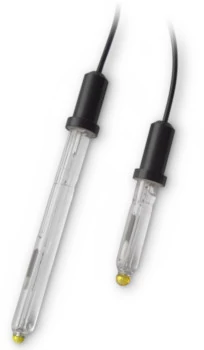
Glass sensors for measuring pH integrate both the pH electrode and the required reference electrode in one unit.
Individual variants differ depending on the purpose of the sensor, mainly in terms of length, shaping of the active part and method of attachment. Sensor cables for laboratory use are terminated with a connector according to the type of instrument used.
Glass electrodes cannot be used in the presence of fluoride ions. In this case, antimony electrodes (available on request) are used. The alternative designations listed below apply to previously supplied sensors.
| Type | Suitable for | Dimensions | Alternative designation |
| 01-29G | Installation with SPO41, SPO42, SPR42, SVK42, PE G3/4D | Ø12.2 x 115 mm | pH 21PT |
| 01-30G | Installation with SPO41ME, SPR41ME | Ø12.2 x 115 mm | pH 21PTC |
| 01-29GK | Installation with PB42V, PB43V, SPO41K, PE G3/4K | Ø12.2 x 57 mm | pH 21PTK |
| 01-30GK | Installation with SPO41MEK, SPR41MEK | Ø12.2 x 57 mm | pH 21PTCK |
| 521-BNC | Installation with SHI63 | Ø12.2 x 59 / 117 mm | - |
| PH21S | MFD79, MFD80 (with transport cover) | - | |
| on request | Laboratory measurements (multiple options) | typ. Ø12.2 / Ø18 x 115 mm | - |
ORP sensors
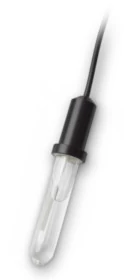
Sensors for measuring ORP integrate both the platinum electrode and the required reference electrode in one unit.
Individual variants differ depending on the purpose of the sensor, mainly in terms of length and method of attachment. Sensor cables for laboratory use are terminated with a connector according to the type of instrument used.
| Type | Suitable for | Dimensions |
| Pt271T | Installation with SPO41, SPO42, SPR42, SPO41ME, SPR41ME, SVK42, PE G3/4D | Ø12.2 x 115 mm |
| Pt271TK | Installation with PB42V, PB43V, SPO41K, SPO41MEK, SPR41MEK, PE G3/4K | Ø12.2 x 57 mm |
| on request | Laboratory measurements (multiple options) | typ. Ø12.2 / Ø18 x 115 mm |
- Downloads:
 ORP sensors dimensions
ORP sensors dimensions
Conductivity sensors
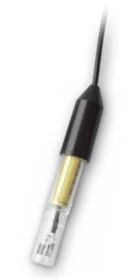
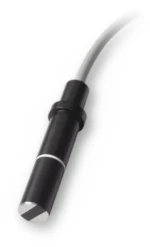
Classic glass sensors with platinum electrodes (series C21, C29) excel in chemical resistance and a wide range of operating temperatures. Due to their shape, however, these sensors are difficult to clean and are therefore not suitable for measuring contaminated water - these sensors cannot be used with automatic sensor cleaning.
The CS21 sensor is better suited for industrial applications. Its robust stainless steel electrodes are arranged in one plane, which allows them to be easily cleaned (especially by the automatic mechanism of the SPO41ME and SPR41ME probes) and thus to measure even heavily contaminated samples. However, the materials used (stainless steel, PVC, Polyethylene terephthalate) limit these sensors to a less aggressive environment, with a limited range of working temperatures.
In connection with the advanced technology of INSA instruments, the listed two-electrode sensors can successfully measure even very high values of conductivity (exceeding 100 mS/cm).
| Type | Suitable for | Dimensions | Temperature sensing element | Operating temperature |
| C21 | Installation with SPO41, SPO42, SPR42, SVK42, PE G3/4D | Ø12.2 x 115 mm | None | -5 to +105 °C |
| C29 | Installation with SPO41, SPO42, SPR42, SVK42, PE G3/4D | Ø12.2 x 115 mm | NTC thermistor | -5 to +105 °C |
| C21K | Installation with PB42V, PB43V, SPO41K, PE G3/4K | Ø12.2 x 57 mm | None | -5 to +105 °C |
| C29K | Installation with PB42V, PB43V, SPO41K, PE G3/4K | Ø12.2 x 57 mm | NTC thermistor | -5 to +105 °C |
| CS21 | Installation with SPO41ME, SPR41ME (or SPO41, SPO42, SPR42, SVK42, PE G3/4D) | Ø14.5 x 115 mm | None | -5 to +50 °C |
| CS21K | Installation with SPO41MEK, SPR41MEK (or PB42V, PB43V, SPO41K, PE G3/4K) | Ø14.5 x 57 mm | None | -5 to +50 °C |
| on request | Laboratory measurements (multiple options) | typ. Ø12.2 / Ø18 x 115 mm | optional | -5 to +105 °C |
- Downloads:
 Conductivity sensors - dimensions
Conductivity sensors - dimensions
Ion selective electrodes
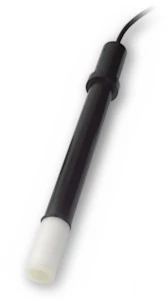
Ion selective electrodes are sensors designed for the measurement of specific chemical ions in a solution, both in laboratory and industrial applications.
Not all ISE sensors include a reference electrode - in its absence, a separate reference electrode must be used. For industrial applications, a suitable probe or flow-through unit must be used that allows at least two sensors to be installed.
The dimensions of the industrial version of these sensors (Ø12 x 115 mm) are suitable for probes SPO41, SPO42, SPR42, SVK42, PE G3/4D, SPO41ME or SPR41ME. A laboratory version of similar dimensions is also available, with a cable terminated with the appropriate connector according to the device used.
The ion-selective electrodes supplied with our devices are sourced from third-party suppliers. More detailed information and the current availability of the variant suitable for a specific device will be specified upon request.
| Type | Ion | Alternative designation |
| 07-35 | NO3- (Nitrate) | 20-31, 25-32 (combined) |
| 11-35 | NH4+ (Ammonium) | 20-10, 25-10 (combined) |
| 19-35 | K+ (Potassium) | 20-19, 25-19 (combined) |
| 20-35 | Ca++ (Calcium) | 20-20 |
| 09-37 | F- (Fluoride) | 20-09, 25-09 (combined) |
| 17-37 | Cl- (Chloride) | 20-17, 25-17 (combined) |
Reference electrodes
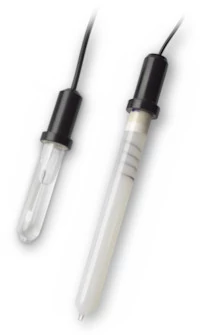
For sensors that do not have an integrated reference electrode, separate reference electrodes are required – this is often the case with ion-selective electrodes. Since a pair of separate electrodes is then used, industrial applications will need a suitable probe or flow-through unit that allows at least two sensors to be installed.
Commonly supplied sensors for measuring pH and ORP have the required reference electrodes already integrated, so there is no need to supplement them with additional electrodes.
| Type | Suitable for | Dimensions |
| RAE111 | Installation with SPO42, SPR42 | Ø12.2 x 115 mm |
| RAE111K | Installation with PB42V, PB43V | Ø12.2 x 57 mm |
| on request | Laboratory measurements (multiple options) | typ. Ø12.2 (Ø18) x 115 (145) mm |
Temperature sensor TTK21

Separate temperature sensors are primarily used to compensate for the temperature dependence of sensors not equipped with built-in temperature sensing. This improves the accuracy of the measurement. The measured temperature reading is usually also available as an output for the user.
| Type | Suitable for | Dimensions | Case material |
| TTK21PL | Industrial probes | Ø14 x 115 mm | Stainless steel |
| TTK21PM | Industrial probes | Ø14 x 94 mm | Stainless steel |
| TTK21PS | Industrial probes | Ø14 x 60 mm | Stainless steel |
| TTK21PX | Industrial probes | Ø10 x 40 mm | Stainless steel |
| TTK21L | Laboratory use | Ø12 (Ø14.5) x 115 (145) mm | Glass |
| Sensor type | NTC thermistor | ||
| Measurement range | -5 to +105 °C | ||
| Compatibility | MFD79, MFD80, MFD88 | ||
| Resistance at 25 °C | 3000 Ω | ||
- Downloads:
 Temperature sensors TTK21 - dimensions
Temperature sensors TTK21 - dimensions
Temperature sensors TNiK21, TNiK115
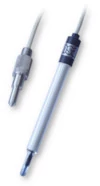
Separate temperature sensors with nickel-type sensing element are only compatible with some older types of our devices. Pay attention to the data in the table.
| Type | Suitable for | Dimensions | Case material |
| TNiK21 | Industrial probes | similar to TTK21 (multiple options) | Stainless steel |
| TNiK115 | Laboratory use | Ø12 (Ø14.5) x 115 (145) mm | Glass |
| Sensor type | Nickel | ||
| Measurement range | -5 to +105 °C | ||
| Compatibility | MFD77, MPH77, MPI77, MFD77PHK, MSV77 (MPH66, MFD66, MFD66PHK, MPI66, MPH66L, MPH44P, MPH44L, MPH44LN, MPH44LT, MPH44, MPH44E) | ||
| Resistance at 0 °C | 2000 Ω | ||
